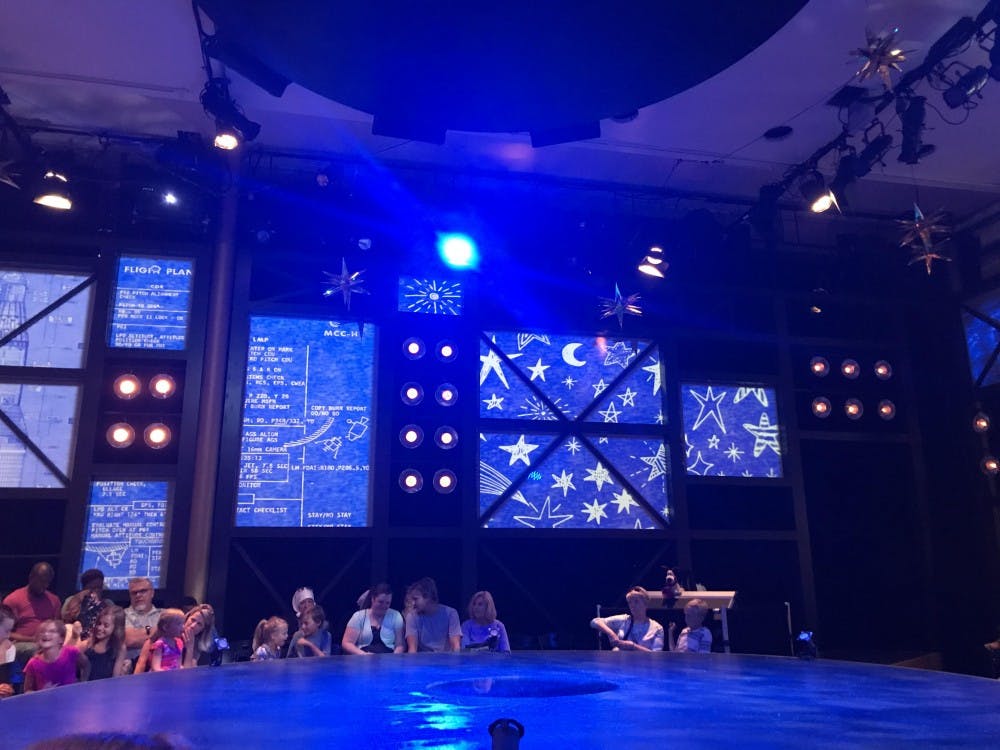This year marks the 50th anniversary of the Apollo 11 moon landing, and the Kennedy Center’s Theatre for Young Audiences program celebrated with the musical “Earthrise.” The world premiere commission ran from July 18 to Aug. 4 and is part of the center’s yearlong Human Journey initiative. The show was directed at an audience of mainly children, yet I thought that it was a well-crafted work of theatre in its own right. I hadn’t felt that much whimsical joy while watching a musical in a long time.
“Earthrise” tells the stories of three children of influential NASA employees involved in the Apollo 11 moon landing. Ricky (David Landstrom) feels distant from his astronaut father (Joe Mallon) and hopes for his safe return from the mission. Andrea (Ayanna Hardy), the daughter of a mathematician (Nicole C. Julien), wants to become an astronaut herself, but the kids at school tell her she can’t because she’s a black girl. Sophia (Chani Wereley) is an artist who wants to be understood by her engineer father (Stephawn P. Stephens) who helped design the shuttle, but feels like they live in two completely different worlds.
My heart ached with every obstacle the kids faced and soared with every adventure they embarked on throughout the story. Director Dawn Monique Williams successfully staged this show for a theater in the round, which encouraged engagement from its young audience. The adult actors playing the kids — Landstrom, Hardy, and Wereley — were the standouts, as they fully embodied the characters and portrayed them with much heart and sincerity. Wereley’s powerful, crystal-clear belt, Landstrom’s incredible portrayal of Ricky’s angst and Hardy’s optimistic, bright energy allowed them to bring these characters to life. Mallon, Julien and Stephens played the parents with a maturity that created strong adults for the kids — as well as the kids in the audience — to look up to. When the kids’ relationships with their parents were clearly established with three short sequences of dialogue in the opening number, I instantly found myself getting attached.
Playwright Lauren Gunderson, who is currently the second most-produced playwright in America, crafted such an engaging, fast-paced story that kids can follow along with ease and that even parents can strongly react to. I do wish that the character of Andrea had a stronger conflict related to her mother. While Ricky and Sophia’s relationships with their parents grow stronger throughout the show, Andrea and her mother are in the same place from start to finish. Still, the inclusion of characters of color like Andrea, Sophia and their families did the show a great service, as it increased the story’s emphasis on embracing diversity and acknowledges the hard work that scientists and mathematicians of color did for the landing.
The score by Brian Lowdermilk and Kait Kerrigan represented everything that makes them a great musical theater composer/lyricist duo. Lowdermilk’s soaring piano and synthesizer riffs sounded otherworldly at times, with the help of orchestrations by Lloyd Kikoler. Kerrigan’s simple, heartfelt lyrics expressed the kids’ dreams in a language that children can identify with. To top it all off, her witty math and science references enhanced the score. I especially loved “Escape Velocity,” a song sung and danced with confidence by Hardy, Wereley and Julien about how they can break the barriers they face as women in their respective careers. Additionally, the choreography by Tiffany Quinn brought all the characters to life with boundless high energy.
The emphasis on the power of math and science is reflected well in this musical, and the technical elements support this. I loved how Andrew R. Cohen designed the set to fit a theater in the round, with panels for projections to be set on the walls all around the room and no furniture on the stage at all. The large model of Earth that was slowly revealed from the ceiling towards the end of the show was also spectacular. The projections, designed by Patrick W. Lord, cleverly changed to fit each setting, from Mission Control to outer space itself, and featured actual NASA footage.
The magic of space didn’t stop with the set and projections, though; it’s propelled further by all the other design elements. Alberto Segarra’s lighting design provided beautiful schemes to enhance the moments where the children imagined they’re in space. Jeannette Christensen’s costumes distinguished the kids from the adults well, with bright colors and childlike elements like a cute pink beret for Wereley as Sophia, the artist, and more realistic costumes for adults, such as Ricky’s father’s spacesuit. Christopher Baine’s sound design tied the auditory elements of the show together well, especially in the balance of volume between the background music and singers (also due in part by music director William Yanesh).
Overall, I think this show could go on to have great future success with companies that produce shows for the Theatre for Young Audiences program with educational theatre settings. The impact of “Earthrise” reaches far, connecting with young and old audiences alike.
dignacio@theeagleonline.com





